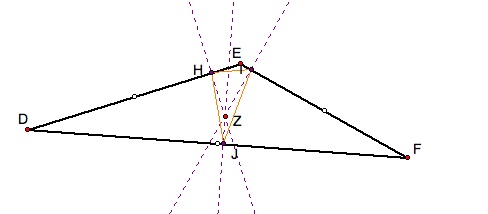
Explored By:
Aubrey D. Johnson

Explored By:
Aubrey D. Johnson
We will investigate how a pedal triangle is made and the effects of moving the "pedal point," P. First we will start with an arbitrary triangle, ABC.

We will now pick an arbitrary point on the plane, let us call this point P.

Now we will make two perpendicular lines. One perpendicular line will be from P to an extension of line AB. Another perpendicular line will run from P to an extension of line AC. The final perpendicular line will run from P and intersect with line BC.

I went ahead and labeled all of the intersections, R, S and T, in order to distinguish them from triangle ABC. Now we will connect point R to point S, point S to point T and point T to point R. These lines will be in lavender.
When we get rid of the extra purple lines and just show the purple triangle we see what happens to the purple triangle (RST) as we move P inside triangle ABC. Here are some pictures of P in different areas around ABC, and how the placement of P affects the look of RST.


Now you can experiment with P using the Pedal Script Tool.
Now that we see what a random point outside the triangle can do. Let us investigate what would happen if P was the centroid of the triangle. First let us find the centroid of triangle. We will be using a new triangle, DEF. Remember, a centroid is where a triangles medians connect. These medians are created by connecting a line from a vertex with the midpoint on the opposite leg.

Next we will create the pedal triangle using Z. We will connect Z to each side of the triangle using perpendiculars. We will then identify the intersections of these perpendiculars with its respective leg on the triangle. For simplicity, we will also get rid of the gray lines, we will, however, keep the white intersection points as reference points.

We now have points H, I and J. We will connect H and I, I and J and H and J to form the triangle HIJ.

We have now created a pedal triangle (HIJ) using the Centroid (Z). Let us see what happens to HIJ as we move a leg of DEF.



Now that you have seen how altering DEF effects HIJ, its your turn to play. Use the Centroid Pedal Script tool to see what happens.
Centroid Pedal Triangle Script